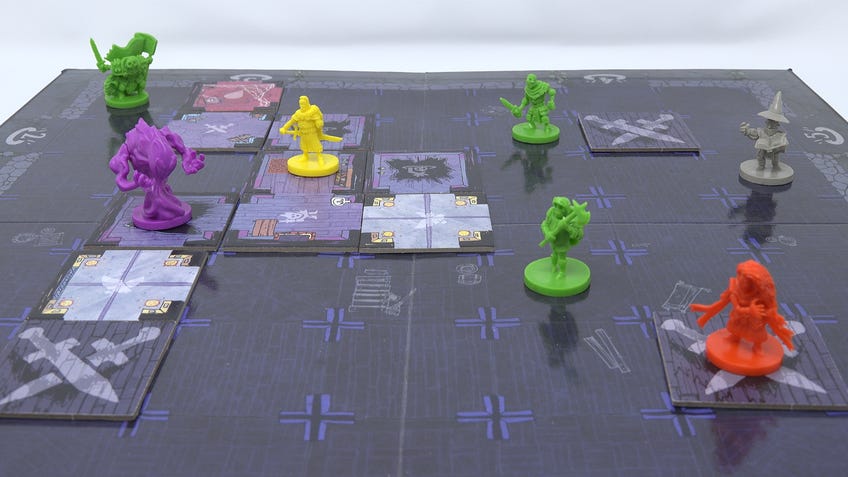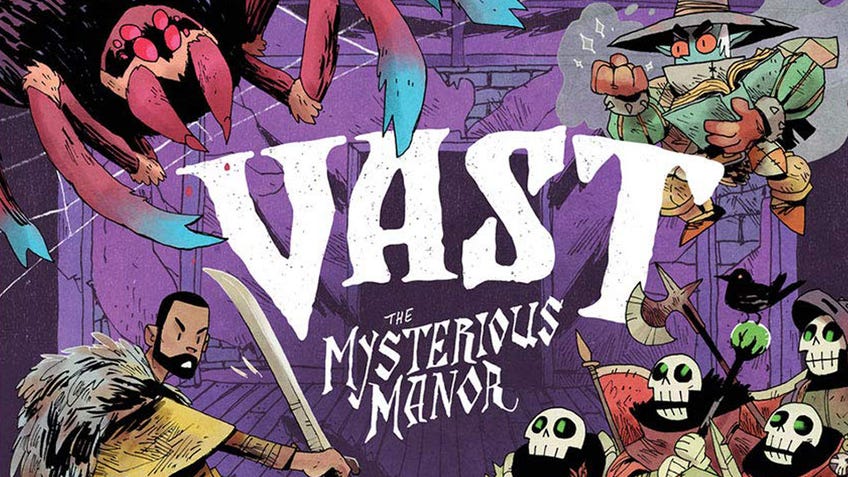Vast: The Mysterious Manor board game review - an immensely ambitious, but incredibly demanding asymmetrical dungeon-crawler
Vastly disappointing.
I’ve now played many games of Vast: The Mysterious Manor, in many different settings, with many different people, and I still don’t really know what I think about it. My feelings towards Vast are as complicated and messy as the game itself. I really want to like it, but almost every experience of actually playing the game has dissolved into frustration and exhaustion.
Vast: The Mysterious Manor is a standalone sequel to Vast: The Crystal Caverns, which was released sometime back in 2016. As with its predecessor, Vast: The Mysterious Manor is an asymmetrical dungeon-crawler for one to five players, wherein each role provides a fundamentally different way of playing and winning the game.
The very first word that springs to mind when considering this concept is ‘innovative’, and Vast certainly does make a strong first impression with its towering collection of tokens, cards and standees; Vast is most certainly vast. (Sorry, that’s the last time I’ll make that pun.) By the end of several long and confusing games, though, the main word you’ll come to associate with the experience of playing Vast is ‘tiring’.

The game’s setup and ruleset can differ greatly depending on how many players you have and which roles they decide to pick, but the general experience is relatively the same. The definitive version of Vast involves every single one of the game’s roles: the Paladin, the Giant Spider, the Skeletons, the Manor and the Warlock, who each have their own unique routes to victory. The paladin must steadily gather enough strength to kill the spider, the spider needs to escape the mansion by feeding on blood and laying eggs, the skeletons work together to eliminate the paladin, the manor has to complete rituals by charting paths through its rooms, and the warlock is trying to successfully place enough curses on poltergeists and treasure. You even have the option to swap out certain roles for the ones found in Vast: The Crystal Caverns, so the game has huge potential for replayability.
For a game that lives and dies by the variety of its roles, Vast: The Mysterious Manor certainly provides quite the selection. We’ve got a role built for standard dungeon-crawling (the paladin), one for tactical squad combat (the skeletons), another for resource management (the giant spider) and even some for solving spatial puzzles (the manor and warlock).
We actually had access to the Kickstarter version of the game which comes with some nicely detailed miniatures not found in the retail release, and, of course, Root illustrator Kyle Ferrin’s art continues to be undeniably charming. Vast’s mechanical scope is absolutely enormous and really quite admirable. Having missed the original Crystal Caverns I had never played a game quite like The Mysterious Manor. Whilst you’re working your way through its groaning table-worth of major and minor gameplay elements, you will come across some really great ideas. For example, the giant spider has three distinct forms the player can adopt each turn - each with its own unique set of abilities - and whenever they are hit by the paladin in one of their singular forms (giant spider or sorceress), they explode dramatically into smaller spiderlings and skitter away to safety.

Herein lies the problem: are these clever ideas enough to justify the sheer amount of work you have to put in to reach them?
It’s not just the act of setting things up for a full five players (which takes a fair bit of time in itself); it’s also having to learn how each of the five roles work, alongside the game’s overall ruleset. Part of the fun of Vast is being able to experience the game from the unique perspective each role provides, but doing this requires you to essentially learn the game afresh each time - or at least, until you’ve played each role enough to have the rules for each one down. This problem is especially apparent when playing with an entirely fresh set of players, even if you yourself know the rules. Yes, players could take it upon themselves to learn their role in advance (which is what I asked my fellow players to do) and some people are happy to, but this a lot to ask for a casual night of gaming. Even then, doing this doesn’t necessarily solve all of Vast’s ruleset problems as we quickly found out during subsequent playthroughs of the game.
Even once you’ve gotten past this particular hurdle, the confusion around Vast’s complicated ruleset continues throughout the entire game. I might as well have permanently glued the rulebook to my hands for how frequently I was searching through its pages, even during the second, third and fourth games I played. It certainly doesn’t help that the rulebook itself fails to provide clear answers to some pretty important questions, instead featuring rather some confusing inconsistencies in its own terminology, and ultimately, leaving players to figure out some of the more unknown aspects themselves. Were you able to play the game on multiple occasions with the same group of friends, safe in the knowledge that you were all entirely competent in its ruleset, then you may be able to uncover Vast’s true charm. But throughout the course of our many playthroughs, we were never able to overcome the barrier erected by the game’s overwhelming ruleset to find the real fun underneath.

Easily the biggest disappointment when it comes to playing Vast: The Mysterious Manor is the severe lack of interaction between players. Whilst having such unique roles is novel, it does mean that most players won’t have a clue as to what their opponents are doing during their turns, unless it directly applies to their role or they know the rulebook back-to-front. Like many asymmetrical games Vast has its very own ecosystem where one player’s actions are supposed to have an impact on another’s. This does happen in Vast on occasion, such as whenever the warlock is forced to drop half their curses and run away should another figure enter their space. And there are undoubtedly consequences to this, as it pushes the warlock further away from their goal, but does result in them receiving additional spells (which is a nice example of some good balancing). However, there just aren’t enough instances of this kind of interaction; those moments that change the state of who is winning from one player to another. Ultimately, the interactions that keep players invested in what's going on during the game. Certain roles do involve some opportunities for more direct interaction, such as the skeletons needing to battle the paladin, but roles like the manor and warlock might as well be their own separate games for all the interconnectivity they provide.
Whilst playing a two- or three-player game does undoubtedly solve some of the more confusing rule issues and speed up the slow pacing, it lacks the grandiose feeling that comes with experiencing the game’s entire ecosystem as intended. These modes ultimately feel like an afterthought, and when there are games specifically designed for two or three players out there, you’d be better off picking one of those instead of Vast.
It’s a crying shame really because, with all its varied game modes and roles, Vast: The Mysterious Manor has so much potential. But instead of being elevated by its many gameplay possibilities, Vast almost crumbles under the weight of it all.

